Unfortunately, tooth extraction in cats is quite common, since many animal owners, out of ignorance, do not care for the cat’s oral cavity. Therefore, they come to the clinic with advanced cases and the teeth are removed.
Tooth extraction in cats occurs only when treatment no longer helps. It must be remembered that many dental diseases are asymptomatic, so it is necessary to periodically examine the oral cavity so that you do not have to resort to such a procedure.
In what cases does a veterinarian recommend tooth extraction?
Let's look at the cases in which teeth are removed.
- Incorrect placement of milk or molars, which interferes with the normal functioning of the animal - the soft tissues of the oral cavity are damaged.
- In severe cases, where conventional treatment has not yielded results - feline lymphoplasmacytic stomatitis.
- Teeth that are close to each other is called crowding. In this case, there is a risk of getting sick because Food will accumulate between the teeth and this will lead to an inflammatory process.
- Internal root resorption
- External root resorption
- Milk teeth that did not fall out on time on their own, but the molars have already begun to grow and the milk teeth interfere with the growth of new teeth.
- Teeth located under the gum mucosa are also subject to removal. They have not erupted, but a cyst may form under the gum and this will harm the adjacent teeth.
- The indication for tooth extraction is periodontal disease.
- Odontoclastic resorptive lesion of teeth – classes 2,3,4
Tooth extraction is carried out only under anesthesia. After tooth extraction, your pet must have the wound sutured, otherwise there is a risk of infection, and the wound will take a long time to heal.
Symptoms: how does pathology manifest itself?
A sign that something is wrong may be the animal’s desire to hide away from everyone.
If a cat has a broken fang, the pet does not always openly show that something hurts. Therefore, the owner may not know when the animal’s tooth was knocked out. However, severe pain is present because the chipped piece of dental structure damages the tissue of the lip or the inside of the cheek. Symptoms:
- jaw soreness;
- headache;
- the cat hides in a secluded place;
- reluctance to communicate with the owner;
- difficulty chewing;
- food falling out of the mouth during feeding;
- swelling and redness of the gums near the damaged tooth;
- bleeding;
- bad breath;
- deterioration or loss of appetite;
- change in the appearance of the bone formation, its loosening.
The procedure for removing teeth from a cat or how to pull a tooth out for a cat
Provide your pet with proper dental care: brush his teeth at least once a week, periodically remove tartar, give vitamins and periodically visit a veterinarian for an oral examination. Even if a cat’s tooth was pulled out and everything else is fine, this does not mean that further care is not needed.
Only a veterinarian can remove a tooth from a cat after first administering anesthesia. If a cat's teeth have been removed, it is necessary to first check the condition of the gums in this place so that inflammation does not appear.
Why does a cat's teeth break?
A cat's incisors, canines, and molars consist of enamel, dentin and pulp. Under the influence of unfavorable factors, the enamel becomes thinner and cracks appear on it. Due to damage, the tooth becomes loose and destroyed. A kitten's teeth can break if the change from milky bone formations to permanent ones is disrupted. In addition, in babies they are still fragile, so even a slight injury to the muzzle can lead to a tooth fracture. Main reasons:
- poor nutrition, especially if the owner lets the cat chew bones;
- lack of vitamins and microelements;
- diseases of the oral cavity - gingivitis, periodontal disease;
- traumatic injuries of the jaw;
- falling or jumping from a height and hitting the face;
- toys made of hard material or not intended for animals;
- auto injury.
The cat broke a tooth: what to do?
If your cat has a broken tooth. First of all, check whether there is inflammation, what condition the other teeth are in, whether it hurts the cat to eat, whether there is discomfort when eating, and in general, pay attention to the behavior of the animal; perhaps the cat has a toothache.
If a cat has a broken tooth and it does not cause concern to the animal, there is no need to do anything; at home this is not as important as for wild cats for hunting. If there are still nuances, something is confusing, it’s better not to delay.
If your cat breaks a tooth or knocks it out at the root, you can get a crown. In some cases, it is necessary to remove a cat's tooth. The same thing is done if the cat knocks out a tooth.
Causes and symptoms
Many reasons contribute to the loss of fangs:
- cracks, damage to the root or crown will lead to such loss;
- inflammation in the oral cavity (red gums are the first sign of gingivitis, which can cause tooth loss);
- a careless fall often leads to injury to the fangs;
- When fighting with another cat, the animal can injure its jaw, which will lead to a swollen muzzle and loose teeth.
Further treatment and care depends on exactly how the tooth broke and what condition it is in.
To begin identifying the problem, you should pay attention to the symptoms. Sometimes the broken part does not bother the pet, in such cases it is difficult to notice the signs, but this does not mean that treatment can be started. At a late stage, the animal begins to have a headache, a fever, and a swollen jaw. The first symptom that should alert the owner is a complete refusal of food and passive behavior that accompanies the desire to hide in a deserted place. Additional complications that may arise if a cat breaks a canine tooth:
- Changing the position of the fang and color - it will stick out unnaturally from the animal’s mouth.
- The swelling will spread throughout the entire face.
- Poor appetite.
- Passive behavior - an active cat will stop playing and biting.
The cat's mouth should be examined by a veterinarian. After the examination, an x-ray and blood test will be done. The tooth is removed if the cat's fang is broken at the root and treatment will no longer help. A harmless situation when a kitten undergoes an age-appropriate change of teeth, which does not involve outside intervention.
Cat's tooth is loose
If a cat's tooth is loose, there may be several reasons for this. An adult cat may have a loose tooth due to a lack of vitamins or poor nutrition. Also note that you should not give too much fish to your cat, as vitamin B is washed out of the animal’s body. If a kitten’s tooth is loose, it may be a baby tooth and will soon be replaced by a molar. In any case, if you are not sure about the correctness of the treatment or prevention you have chosen, contact your veterinarian, he will really help determine the causes of the disease, and not just see the consequences.
| In our cattery you can “buy a real British kitten.” We have many different colors, we will help you choose and answer all your questions! |
Treatment
This process directly depends on the nature of the damage. Damaged dentin is treated with fluoride and sealant. If the fang is more damaged and cannot be restored to a healthy state by any means, it is removed.
We recommend the article: How to recognize and treat gangrenous stomatitis in a cat
In some cases, the animal is given a filling. Special plates are used if the crack is small. If the crack appeared because the jaw was injured and, in addition to problems with the teeth, abrasions and scratches appeared, then the jaw is treated first. The veterinarian is able to return the tooth to its original place if it has shifted. In this case, the main thing is to immediately contact a veterinary clinic, because an inflammatory process may begin.
Cats quickly adapt to life without a fang, and this will not affect his abilities or behavior in any way. The animal will be able to chew food easily and the absence of a fang will not cause any discomfort.
Prevention
To prevent a cat’s fang from breaking, veterinary dentists recommend that owners monitor their pet’s oral hygiene and regularly brush their teeth with special products for animals. When tartar appears, you need to do ultrasonic cleaning. Owners must choose the right toys for their pet and ensure that they are made of soft materials. It is necessary to feed your cat properly, completely excluding bones or too hard food. Super-premium and premium food are suitable. If recommended by your veterinarian, you can add a calcium supplement to your diet. It is also important to protect the cat from injuries and falls.
What to do if a tooth is broken or pulled out?
Diagnostic tests
An x-ray can help explain the cause of an animal's problem.
If a cat breaks a tooth, the owner must urgently take the pet to a veterinary hospital. To determine the degree of damage to the bone formation and surrounding tissues from protruding fragments, diagnostic procedures are performed, such as:
- panoramic radiography of the jaw or individual fragments;
- examination with a periodontal probe.
Treatment methods
The owner is strictly prohibited from touching, loosening or removing a chipped tooth on his own; this can lead to greater injury to surrounding tissues and the penetration of pathogenic bacteria.
If a cat's fang has broken off, the following types of therapy are used in veterinary dental practice:
Sometimes the problem is solved by installing a filling.
- Filling. The crack is closed with fluoride or sealant if there is no damage to the pulp. If the chip has reached the pulp, the dental canal is filled and a crown is installed.
- Delete. When a fang is broken at the root or more than half of the tooth is destroyed, it has to be pulled out. Removal is carried out under anesthesia. If a kitten is injured, the baby tooth is easily removed or falls out on its own, since it does not yet have a root.
- Installation in place. The method is necessary when a bone formation is displaced from the socket.
- Therapy for jaw damage. It is carried out when a fracture of the mandibular joint or facial bones of the skull is diagnosed. Treatment is prescribed individually, depending on the severity of the injury. After treatment, the veterinarian dentist solves the problem of the diseased tooth.
Traditional methods
Alternative treatment should not replace traditional treatment and should only be used after consultation with a veterinarian. You can apply the “Strong Teeth” gel to your gums, which relieves inflammation and has antiseptic properties. If a tooth has been pulled out, at home you can rinse your cat’s mouth with decoctions of bactericidal herbs - chamomile, St. John’s wort, sage. The plants will not harm if the pet accidentally swallows the liquid dosage form. Recipe:
Chamomile decoction can be used to rinse the animal's mouth.
- Take 5 g of herb and pour 200 ml of hot water.
- Let it brew, cool, filter.
- Pour into the oral cavity with a syringe without a needle in small portions, directing the stream so that the herbal medicine gets to the affected area.
Causes
A tooth can break for many reasons. A small crack in the enamel leads to the destruction of dentin and exposure of the pulp, which can lead to tooth loss. The tooth root or crown may also be partially or completely damaged.
Typically, dental injuries in pets occur due to bad falls, car accidents, fighting with each other, or injuries to the jaw bones.
A pet’s teeth can break above, below or at the gum level, and the fracture itself can be either vertical or horizontal; subsequent treatment will depend on these indicators.
Treatment methods
Treatment options for a cat with a chipped fang depend on the extent of the damage. If only the child’s middle layer was damaged, the veterinarian coats the tooth with a special sealant or fluoride. These substances serve as protection against infection of the pulp, and they also minimize pain. If severe damage has been diagnosed, the cat’s fang has broken at the root, then it must be removed. If the damage to the element is very deep and reaches the inner layer - the pulp, then it is recommended to seal the nerve canal and cover it with a crown.
If the owner notices small cracks on the surface of the fangs, he should immediately contact a veterinary clinic. In this case, the application of special plates is required to prevent loss. If the crack was caused by trauma to the jaw, then treatment of jaw injuries is indicated first. In severe situations, the tooth moves out of its socket. There is an urgent need to put it in place. Next, the doctor chooses a method for fixing the element in the desired position.
Caring owners should not worry too much about their pet’s lost fang. It should be understood that cats do not eat with their fangs. They serve only as a hunting tool. Pets do not need this type of teeth, since they do not have to get their own food. Animals quickly get used to the new conditions of chewing food without fangs. You should only be wary of the consequences if you do not treat the diseased canine in a timely manner. An infection may develop and an inflammatory process may begin. To prevent severe cases, it is necessary to promptly treat oral diseases in your pet. A healthy animal will please its owner for a long time.
Symptoms
A damaged element may show absolutely no signs of damage; the owner will notice the broken part only upon inspection. In difficult situations, the cat suffers greatly from pain in the gums, jaw, and head. One of the first signs of the disease is a refusal to eat and a constant desire to hide in a far corner. If a cat has a broken fang, the following symptoms will be observed:
- changing the color of the enamel and the shape and location of the element;
- fangs move in the wrong position;
- tissue swelling becomes noticeable on the face;
- the individual refuses to eat;
- the animal stops playing and chewing toys.
If you notice the above symptoms, you must contact a veterinary clinic. Damage of this nature is suspected by the animal emergency team. Before treatment, the veterinarian performs a visual examination, x-rays, examination of the broken element using a periodontal probe, as well as a clinical and biochemical blood test.











